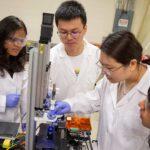
Powering knowledge of solar cell components for a brighter future

Above: Assistant Professor Zachary Holman is one of 10 Ira A. Fulton Schools of Engineering faculty members to receive an National Science Foundation CAREER Award for 2018 to 2019. He is augmenting the behavior of solar cell electrical contacts to increase the efficiency of solar energy conversion.
Ten faculty members in the Ira A. Fulton Schools of Engineering have received NSF CAREER Awards between September 2018 and April 2019.
Each layer of a solar cell performs an important function to turn sunlight into usable electricity. The solar research community knows much more about some layers than others — and more knowledge translates to more efficient solar power.
Zachary Holman, an assistant professor of electrical engineering in the Ira A. Fulton Schools of Engineering at Arizona State University, is focused on understanding and augmenting the behavior of solar cell electrical contacts, or the layers of material added to the front and rear of photovoltaic absorbers that convert excited electrons into electrical current.
“The solar research community’s ability to identify, make and test the ideal contact has been stymied by a lack of suitable fabrication and characterization tools,” Holman says.
In a five-year, $500,000 National Science Foundation Faculty Early Career Development Program (CAREER) Award project, Holman will develop a new method to deposit thin films of wide-bandgap semiconductors with tight control of the material composition and microstructure.
He will also create a new set of measurements to indicate whether a given contact is performing at its limit, and, if it is not, identify where the energy losses are occurring.
“Together, these will allow us to reveal new information about how contacts work,” he says.
Holman is looking to develop solar cell electrical contacts that are transparent, inhibit the de-excitation of electrons at the absorber surface (also known as passivation) and selectively extract electrons from the absorber.
He’ll test different contact materials on readily available types of cells that already have high-quality absorbers like crystalline silicon and cadmium telluride photovoltaic cells — meaning that he’ll get a better idea of the effect of the new contacts.
If he is successful in this project, Holman expects the research to lay the groundwork for increased solar energy usage in the United States. His work could lead to solar cells that are 10 to 15 percent more efficient than solar cells today — potentially achieving up to 27 percent efficiency. Such efficiency increases would reduce the cost of solar energy generation and accelerate the deployment of solar energy systems. It is estimated that achieving such high efficiency would mean 17 percent of U.S. energy could be generated by solar power by 2030 — compared to only 5 percent in the same timeframe without the kind of advances in solar contact technology Holman is pursuing.
His research project will also help train students for some of the 260,000 jobs in the solar energy industry in the U.S. In a week-long, hands-on Solar Cell 101 course, students will learn to make solar cells and modules from start to finish.
Holman credits ASU for giving him an advantage by being at the forefront of solar energy research in the nation.
“ASU has solar research infrastructure and personnel not found elsewhere in the country,” Holman says. “My team couldn’t conduct the same research anywhere else.”




































